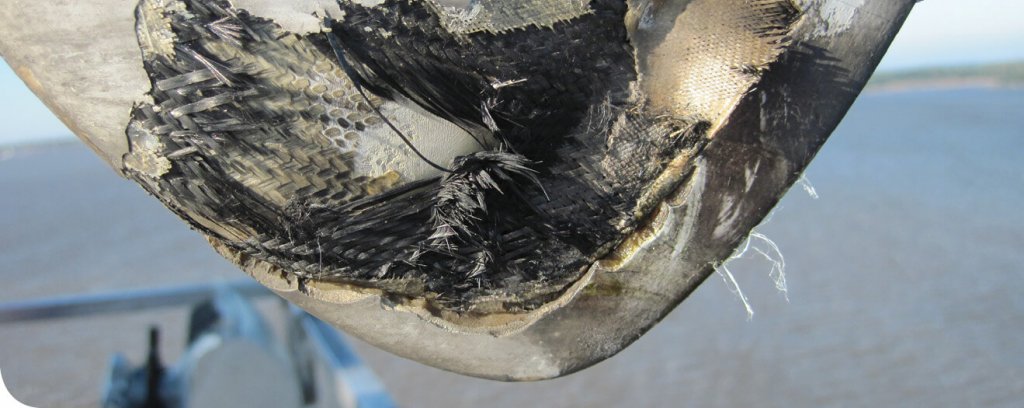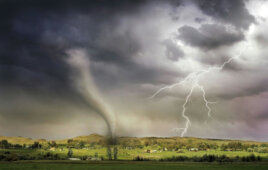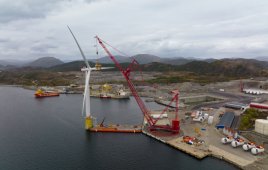Michelle Froese / Senior Editor
MANY WOULD ARGUE THAT TURBINE BLADES are a critical part of a wind generator. Blades are the key component for receiving and maximizing wind energy, so proper care would seem essential to optimal production. Ville Karkkolainen, Managing Director at Bladefence, a blade inspection and repair company, agrees but says what actually happens in field tells a different story.

Havoygavlen Wind Farm is the most northern most wind farm on earth. Weather conditions mean a well designed blade maintenance plan is mandatory.
“Most of the time I feel like we are a fire department being called after the emergency — when the blades are already in devastating and sometimes irreparable conditions,” he said during a presentation at the recent Wind O&M Dallas 2016 conference, put on by Wind Energy Update.
Karkkolainen claims about 90% of Bladefence’s revenues come from project services, meaning significant damage has already occurred by the time the company is asked to service turbine blades. “It’s not only a matter of keeping blades alive for 20 years, it’s also a matter of service and performance during a blade’s lifetime,” he said. “A maintenance plan is essential.”

Lightning strikes are one of the most abusive natural events that blades face. A lightning protection system, imperative for blade protection, may also be required by insurance companies.
It’s no secret turbine blades are damaged by dust, moisture, wind gusts, and lightning strikes. Aerodynamic loads and gravity can also fatigue and damage blades. “Yet there’s very little open data on the subject,” shared Karkkolainen, which is interesting, he said, because we’re in an era of data gathering. “There’s been much discussion on the number of sensors in and on wind turbines, which is true for almost every turbine component — except for the blades.”
He gave the example of a gearbox, which can have dozens of sensors that remotely report to a turbine owner or control center, but blades tend to just have one strain sensor. Strain detection is still one of the most common methods to monitor a blade’s condition. “But these are huge, remote devices with several failure modes. So it is difficult to remotely and reliably evaluate blade conditions from afar, or to make accurate predictions from the collected information.”

The leading edge damage on this blade has been “repaired” with duct tape, certainly not a recommended technique.
Of course, it’s possible to visually inspect blades by use of cranes or skylifts but, for most companies, such equipment is too expensive, so it is saved for maintenance and repairs, explained Karkkolainen. “This leads us to the cameras and drones, which are becoming more widely used today. At the end of the day it’s not so much how data is consistently collected, but how the information is analyzed and used afterwards.”
According to Karkkolainen, the wind industry still lacks the necessary standards or best practices for ideal blade inspections and for consistent collection and analysis of inspection data. For example, after a blade inspection, a wind-farm owner is typically given files full of information that are often challenging to interpret and review with accuracy. “Understanding the issues or root cause of blade damage can be daunting,” he said. “This is especially true after warranty when going from the OEM — which often has a consistent method for measuring blades that is not always publicly shared — to an ISP or to self-performing inspections. It can be difficult at this point to develop a consistent and intelligent database to use for future blade planning and maintenance.”
Developing standards or a transparent and streamlined method for comparing common blade failures will take time. “Unfortunately, this is not an issue that will be solved overnight,” he said. “Eventually, data compatibility from company to company is something to strive for in the industry.”
For this reason, Bladefence has begun collecting blade data over the last few years as part of a database to note and compare consistencies and differences. “Even from a relatively small sample size, it is possible to see trends in root causes and in damage progression in different failure modes and in different turbine types,” said Karkkolainen. “It is possible to track the effects of various environmental factors, such as moisture and freezing temperatures, that can damage blades.”
Aside from Bladefence’s own in-house studies, one study from 3M shows trends from leading-edge blade damage. The study indicated that the effects of weathering on the output of turbines are much greater than previously thought, and that damage caused by airborne objects (such as sand or rain) can reduce the energy output of a turbine by more than 20% per year. “It’s the only publicly available study I know of so there is certainly a lack of available data,” he said. “I don’t think figures from these studies should be interpreted as definitive facts because each wind farm is different, but there are definitely trends worth looking at.”
Karkkolainen presented an example of what can happen when blade damage is ignored. He showed two images, one with a blade that had moderate leading-edge erosion, and another of the same blade a couple years later when the damage was now severe. “It’s worth noting that this took place in under two years,” he said. “Plus, the initial data was there for the customer to act upon. But in this case, they didn’t until it was almost too late. So what began as a manageable condition became a dangerous and nearly irreparable case where the blade could have easily snapped off.”
In Karkkolainen’s experience, blade maintenance and repairs often get pushed aside until later usually due to time or budgetary constraints. “The unfortunate part of this scenario is that these issues are often obvious by year seven or eight of a blade’s life. Yet, as was the case with the turbine in this example [it was at year 11], its blades were no longer available from the OEM. So the option became either to repair the blade at a high cost or to completely write-off the entire turbine.”
For repair techs, this becomes a difficult position. “How do you tell a wind-farm owner that because of their lack of foresight and proper maintenance, they’ve pushed themselves into a position where now they have to scrap the turbine completely — never mind pointing out the health and safety concerns of such a damaged blade?”
Sometimes it’s possible to convince the manufacturer to reproduce a blade, but it is often costly and not necessarily affordable or worth the price. If you think blade maintenance isn’t ignored or often overlooked, think again. His next example showed a photo of a blade on which the damaged leading edge was duct-taped together.
“This turbine is owned by one of the largest utilities in the world with more than 1 GW of installed capacity,” he said. “This isn’t about blaming the company, but I show this image to drive home a point. We have a vision in this country of 10% more wind energy by 2020, which is important but we also have to face reality and the state of today’s turbines. If we’re going to have an honest discussion about generating reliable and economical wind energy of the future, let’s start today.”
Karkkolainen pointed out that ISPs are subject to stringent quality control and must submit verifying documents that support their work. “Why shouldn’t there be similar standards for each sector in the industry?” he asked.
He admitted that the wind industry presents unique challenges. It is an interesting industry, he said, and one that presents different ideal conditions depending on the sector or device. “For instance, slip rings and bearings tend to work better in humid conditions but blade repair work should be done in far dryer conditions. So one way or the other, you have to prepare for these challenges.”
One way to do so is by ensuring devices receive ongoing maintenance. Karkkolainen also believes the industry needs more innovation. “I’ve been here for six years and in some ways little has changed. The message, at least from a materials standpoint, is that we need more courage to try new technologies in the market.”
Despite examples of poor blade conditions there are also success stories, even in challenging conditions. Case in point: Havoygavlen Wind Farm, the northern most wind farm on earth, located on the 71st latitude in Norway. “In 2013 when we began as an ISP on the site, they only had five days last year when the temperature was above +15º C, enabling blade repairs with conventional materials — and even so there was always snow on the ground. If this is your weather scope and it’s September, you cannot do anything before June,” he said. “This extreme site underlies the fact that a blade maintenance plan is needed, and should be reviewed or revised year after year.”
But as Karkkolainen also pointed out, extreme conditions should not be the only time a well-devised maintenance plan comes into play. “You have to be proactive when it comes to blade maintenance regardless of site location.”
Insurance companies are slowly starting to require these plans, too. “One of the harshest conditions blades face is lightning,” he said. “We’ve had several cases in Europe in which an insurance company has threaten to deny a claim if the owner could not present data from a lightning protection system (LPS) The owners had not been careful enough in fulfilling their duty by ensuring blade protection.”
In another case, workers found pieces of a turbine half a kilometer away after a thunderstorm. “The insurance company asked how could this happen with a LPS? The root cause analysis showed that it was a combination of a faulty LPS and blocked drain holes at blades tips. This is worth noting because drones or ground-based imagery cannot check drain hold or the condition of the LPS.”
There are places in Germany that lawfully require annual inspections of LPS and drain holes in turbine blades because it’s considered a health and safety issue that can cause catastrophic events.
“Inspection and blade maintenance should be part of the same process and not occur separately,” Karkkolainen advised. “Doing so saves time and repair costs at the time of an inspection. And consider the long-term ramifications. By catching leading-edge erosion early, you can save the blade and potentially a whole turbine from going out of service. Now that’s a positive for the industry.”
Filed Under: Blades, Featured






Slip ring, as a very important component, has widely used in industrial circle.
More information about slip rings in Moflon, please click:www.moflon.com